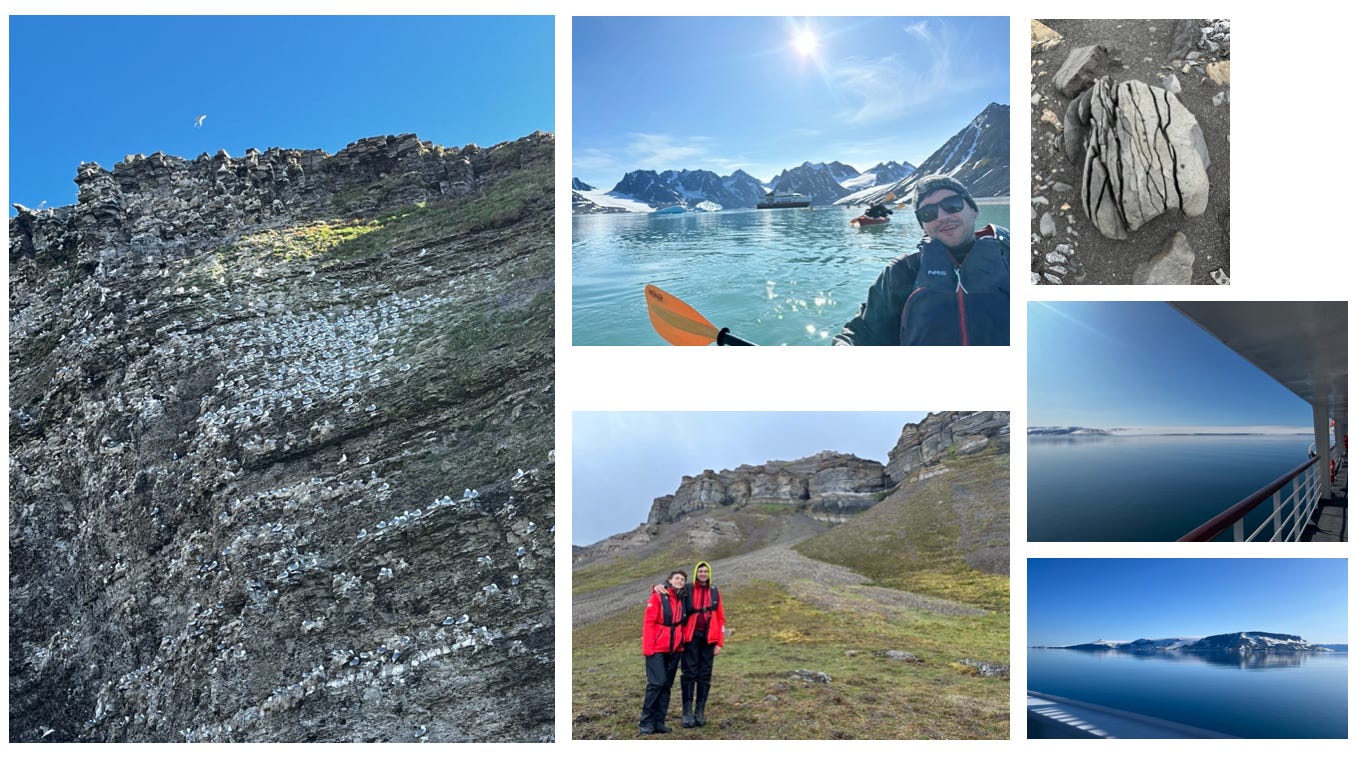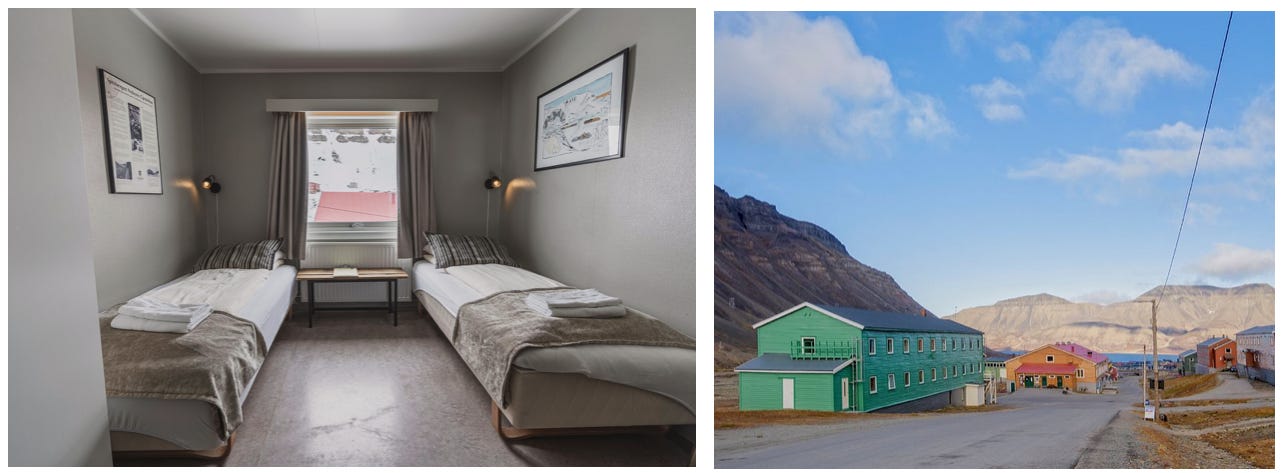#2: Svalbard!
How to visit the northernmost town in the world and a few highlights from my trip
Hi there! If you subscribed recently, thank you 🙏
Bureau of Adventure is a newsletter about the travel businesses and how to take better vacations - beyond the glossy Instagram recommendations.
After a month of vacation, I’ll be back to a weekly(ish) posting schedule starting today.
I spent July in Norway and I want to share some info about Svalbard, the craziest place I visited. Let’s start with some facts:
Svalbard is so far north. The southernmost point is 400+ miles above Norway’s North Cape, and the whole archipelago sits way north of any point in North America. The northernmost latitude we reached on our trip was 80 degrees. For reference, New York City is at 40 degrees. Prudhoe Bay, AK is at 70. Longyearbyen, the capital, is at 78 and easily claims the title of northernmost town in the world.

Picture 1: Svalbard’s position in the Arctic. Source and better map here. Picture 2: Drinking wine on deck at midnight. Note how high above the horizon the sun was. Picture 3: Next sunset on my iPhone weather app. Picture 4: Our northernmost position on the cruise. In the summer, the sun never sets. In fact, it didn’t even touch the horizon in July. The flip side: in the winter, the sun doesn’t rise for several months.
Depending on the season, Svalbard is close to (or surrounded by) the polar ice cap. I took a boat trip among drift ice that had broken off the ice cap.
Svalbard is administered in a strange way. It’s part of Norway, but under an unusual arrangement governed by the Svalbard Treaty. Some outcomes of the treaty are (1) Russia maintains two mining settlements there (2) Military activity is not allowed, and (3) No visas are required to work there - check out this article about living in Svalbard.
There are polar bears, and you need to consider that as part of your planning. Polar bears are larger than grizzly bears, they are carnivores, and they hunt their prey (potentially including humans). These are not like bears in North America. Visitors need to stay with a trained guide with a gun outside the town limits (eg. on any hike).
Svalbard is truly the end of the world.
🚢 My trip
Full disclosure: I worked for Hurtigruten until April 2023, and I booked my cruise at an employee rate. On Svalbard, Hurtigruten is the largest tourism company and I stayed at one of their hotels.
Okay back to our previously scheduled programming 😊. Despite its location, Svalbard is surprisingly accessible. There are direct flights from Oslo to Longyearbyen on Norwegian and SAS.
In Longyearbyen, we stayed for one night at the Coal Miner’s Cabins. Just like a college dorm room, bathrooms were down the hall from our room, but it was quite comfortable and prices were reasonable (about $150/night). A range of lodging options exist in Longyearbyen, from the luxurious Funken Lodge to camping.

We had about 24 hours of free time in Longyearbyen before boarding our cruise, so we booked two activities on the excellent Visit Svalbard page. We ended up taking two hikes (one was originally a kayak tour, but was cancelled due to high winds).
On July 3, we boarded the 200-passenger MS Fram for a 10-night expedition cruise around Svalbard. Highlights from the trip were:
Landscapes - My traveling companion categorized me as a landscapes guy, and I think they’re right 😅. We were surrounded by mountains, fjords, and glaciers. An advantage of Svalbard versus other expedition cruises is there are no days at sea. You almost always have something to look at.
Ice - In addition to abundant glaciers and the icebergs that break off of them, we sailed by (and through) lots of sea ice that had floated off the polar ice cap.
Wildlife - You have to work a bit to find it, but over the course of our trip we saw walruses (on pack ice and on the beach), polar bears (from a safe binocular distance), tons of birds, arctic foxes, reindeer, and blue whales! Our guides were particularly excited about the blue whales since seeing them is rare.
Touching ice and walking in remote places - The major advantage of expedition cruising is the ability to walk on remote beaches, hear and smell nesting birds on a cliff, cruise on small boats at water level, and kayak in remote fjords.
Now a few pictures from the trip…


📖Trip Recipe: How to plan a trip to Svalbard
So how can you go? The basic “recipe” for a trip to Svalbard is as follows:
Step 1: Get to Oslo (and likely stay overnight there)
Step 2: Fly to Longyearbyen
Step 3: Explore Svalbard (more on that below)
Step 4: Fly back to Oslo (and leave buffer afterward in case of delayed flights)
There are three ways to explore Svalbard:
Option 1: Expedition cruises are a popular and easy way to see the remote parts of Svalbard. In fact, they’re the only way to visit the remote parts. Ice conditions change year-to-year (pack ice clears from planned routes at different times each year) so don’t assume your trip will follow the published itinerary. Every cruise is different, and the expedition team adapts the itinerary to the weather and ice conditions on your trip. Generally speaking, if you want to maximize your chances of a circumnavigation, take a cruise later in the season (mid-July or August), when ice is more likely to have cleared.
Most expedition cruise companies offer trips to Svalbard. Companies that have been operating for a while are Ponant, Hurtigruten, Oceanwide, Quark, and Hapag Lloyd, but you can find a full list of on the AECO website. Trips often cost $8,000+, but they include flights to/from Longyearbyen.
The cheapest expedition cruises are on MS Nordstjernen, a classic (ie old 👀) vessel with a lot of character. Be ready for basic accommodations, but you’ll visit great places on a short, affordable trip. Cruises start around $2,000.
Sailing trips are a more adventurous option, and sometimes more affordable. Two examples are Meander and Rembrandt, but the AECO website includes many more sailing options.

Option 2: Hotels in Longyearbyen with day trips. Advantages are more control of your budget, your activities, and the length of your stay in Svalbard. Another major advantage: you can visit Svalbard outside of the summer cruise season. If you want to see Northern Lights or explore the icy winter landscapes, you’ll need to stay in a hotel (or take a tour). Hotel options in Longyearbyen can be found here, and remember to book plenty of activities (boat trips, kayaking, hiking etc) in advance of your visit.
Option 3: Multi-day tours are great if you are more adventurous and want to get farther away from Longyearbyen. Some of my favorites are winter snowmobile or dog-sledding treks, stays at remote cabins, or summer kayaking trips. A full list is available on the Visit Svalbard website.
🗒️Additional notes & tips
Weather is changeable in polar regions. Prepare yourself physically (with clothing), but also make sure you are mentally prepared for plans to change. You’re visiting the ends of earth, not Orlando 😄
Make sure your schedule has buffer in it. It is fairly common for flights to/from Longyearbyen to be cancelled due to weather. I recommend adding a hotel night in Oslo after your trip so you don’t miss a connecting flight home. If you’re staying in Longyearbyen, don't plan a trip that’s too short. You could have a day or two of bad weather with activities getting cancelled. Stay 3+ nights to increase your chances of having some days with good weather and lots of activities.
Book activities, otherwise you’ll be stuck in town. I know I said this already, but it bears (sorry 🐻❄️) repeating. You need a guide to do almost anything because of the polar bear danger. Visit Svalbard has a great booking platform and most tours are listed there.
Consider the winter and spring. The midnight sun is amazing, but I would love to return during the polar night or even better - the spring, when there’s lots of snow AND sunlight.
Dress like a Norwegian. Norwegians swear by wool, and I’m a convert. I’m obsessed with my wool under layers from Norwegian brands Aclima and Norrøna. Check out this explainer on wool layering from Aclima. This is especially important if you go in the winter.
That’s it! Please let me know what you thought of this week’s newsletter. Just email me at jess@bureauofadventure.com.
If you think somebody else would like this, consider forwarding it to them.









What a great article - thanks Jess!!